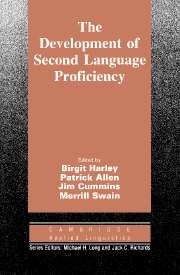Book contents
- Frontmatter
- Contents
- List of contributors
- Series editors' preface
- Acknowledgments
- Introduction
- I THE NATURE OF LANGUAGE PROFICIENCY
- II CLASSROOM TREATMENT
- III SOCIAL AND INDIVIDUAL VARIABLES
- Chapter 9 Social and individual factors in the development of bilingual proficiency
- Chapter 10 Social and individual factors in language acquisition: some models of bilingual proficiency
- Chapter 11 The role of context and age in the development of bilingual proficiency
- Chapter 12 The relationship between first and second languages: language proficiency and language aptitude
- Chapter 13 Response by DBP project members to the discussion papers of Richard Bourhis and Alison d'Anglejan
- IV PRACTICAL AND POLICY IMPLICATIONS
- V THIRTY-FIVE YEARS OF RESEARCH ON BILINGUALISM
- CONCLUSION
- References
- Author Index
- Subject Index
Chapter 9 - Social and individual factors in the development of bilingual proficiency
Published online by Cambridge University Press: 05 October 2012
- Frontmatter
- Contents
- List of contributors
- Series editors' preface
- Acknowledgments
- Introduction
- I THE NATURE OF LANGUAGE PROFICIENCY
- II CLASSROOM TREATMENT
- III SOCIAL AND INDIVIDUAL VARIABLES
- Chapter 9 Social and individual factors in the development of bilingual proficiency
- Chapter 10 Social and individual factors in language acquisition: some models of bilingual proficiency
- Chapter 11 The role of context and age in the development of bilingual proficiency
- Chapter 12 The relationship between first and second languages: language proficiency and language aptitude
- Chapter 13 Response by DBP project members to the discussion papers of Richard Bourhis and Alison d'Anglejan
- IV PRACTICAL AND POLICY IMPLICATIONS
- V THIRTY-FIVE YEARS OF RESEARCH ON BILINGUALISM
- CONCLUSION
- References
- Author Index
- Subject Index
Summary
Several studies in the Development of Bilingual Proficiency project were designed to investigate the relationship between individual and social environmental factors and the development of bilingual proficiency in both majority and minority language learning contexts. In one largescale study of Portuguese-Canadian students (Cummins, Lopes, and King 1987), the relationship between language use patterns, language attitudes, and bilingual proficiency was investigated by means of correlational and regression analyses. In a small sample of beginning school-age children of Portuguese home background, a detailed study of language interaction at home and at school was carried out with a view to relating interactional variables to later academic achievement (Cummins, Lopes, and Ramos 1987). In another minority context, an ethnographic study focused on students attending a French language elementary school in Toronto (Heller 1983, 1984).
The social context of bilingual development among Portuguese-Canadian children
In the large-scale study of grade 7 Portuguese-Canadian students, bilingual proficiency was investigated in relation to family background variables, students' patterns of language use, and their language attitudes. Theoretical issues examined were: (1) the nature of language proficiency indicated by the pattern of relationships within languages – specifically, the extent to which grammatical, discourse, and sociolinguistic competence could be distinguished in context-embedded and context-reduced situations; (2) the cross-lingual dimensions of language proficiency, indicated by the pattern of relationships across languages – in other words, the extent to which there is evidence for a “common underlying proficiency” that accounts for variance in both the bilingual's two languages; and (3) the extent to which proficiency in English and Portuguese could be predicted by language use and attitude variables.
Information
- Type
- Chapter
- Information
- The Development of Second Language Proficiency , pp. 119 - 133Publisher: Cambridge University PressPrint publication year: 1990
Accessibility standard: Unknown
Why this information is here
This section outlines the accessibility features of this content - including support for screen readers, full keyboard navigation and high-contrast display options. This may not be relevant for you.Accessibility Information
- 2
- Cited by
